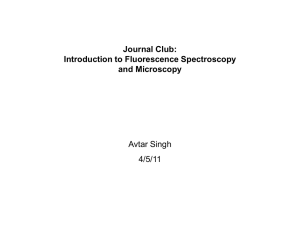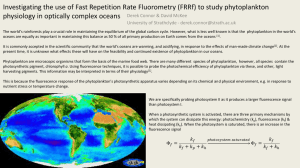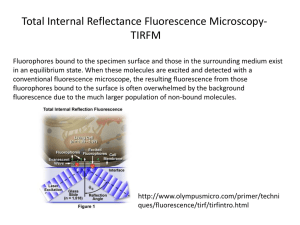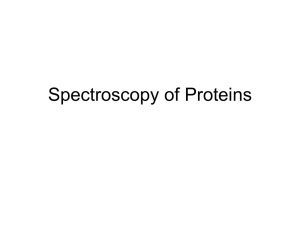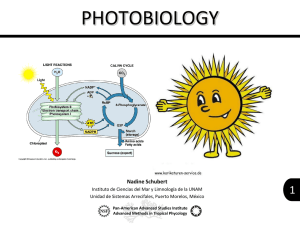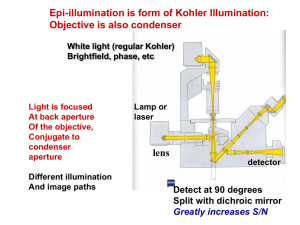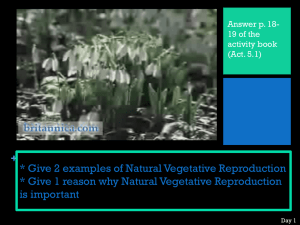Akinetes - Assaf
advertisement
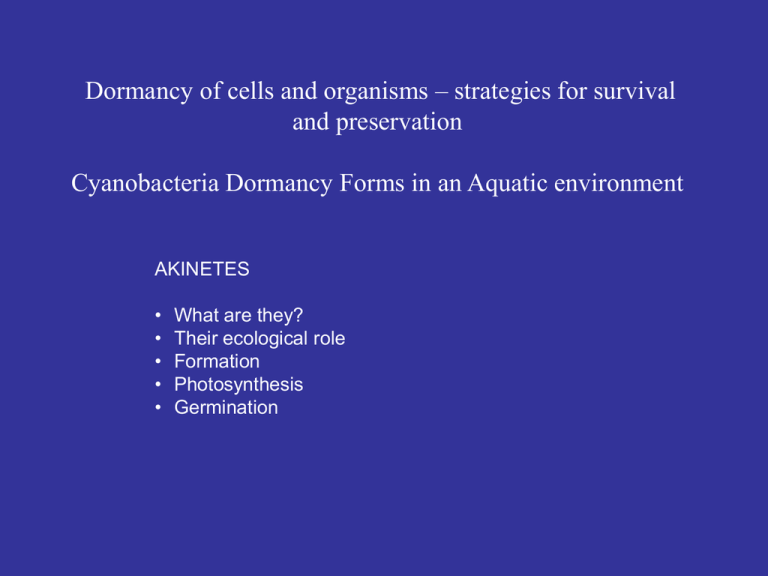
Dormancy of cells and organisms – strategies for survival and preservation Cyanobacteria Dormancy Forms in an Aquatic environment AKINETES • • • • • What are they? Their ecological role Formation Photosynthesis Germination What are they? Akinetes - Cyanobacteria Dormancy Forms Akinetes (from the Greek ` akinetos', meaning motionless) are differentiated thickwalled, resting cells produced by many strains of subsections IV (order Nostocales) and V (order Stigonematales), usually as cultures approach stationary phase. They do not resemble the endospore structurally. They and are not heat resistant, but resist to cold and desiccation. They are larger than vegetative cells and have thickened extra cellular envelope Akinetes contain higher amounts of storage compounds: glycogen & proteins (cyanophycin) and maintain low level of metabolic activities Phosphate deficiency, specific light conditions, UV, simple organic carbon source and un-aerated conditions induce the formation of akinetes Akinetes - Cyanobacteria Dormancy Forms Aakinetes maintain residual metabolic activities as shown by incorporation of 35S into protein and lipid. They consumed 02 in the dark and evolved 02 in the light Essentially every vegetative cell in the filament can differentiate into an Akinete Akinetes germinate to produce new filaments under suitable conditions Akinetes provide cyanobacteria with a means of over-wintering and surviving dry periods The ecological role of Akinetes Schematic summary of the cyanobacteria life cycle (prototype for species of the order Nostocales) From: Hense I & Beckmann A (2006) Ecological Modelling (in press) Development and maturation of Akinetes of Aphanizomenon ovalisporum Australian strain of Aphanizomenon ovalisporum was kindly provided by Lindsay Hunt, Queensland Health Scientific Services. Development and maturation of Akinetes of Aphanizomenon ovalisporum 20mm 20mm Young akinetes perform photosynthetic activity at a similar rate as their adjacent vegetative cells 600 Fluorescence (rel.) 500 400 0 75 110 175 260 365 510 850 1250 300 200 100 0 0 2000 4000 6000 8000 10000 Time (ms) 800 Fluorescence (rel.) 700 600 0 75 110 175 260 365 510 850 1250 500 400 300 200 2000 4000 6000 8000 Time (ms) 10000 12000 Photosynthetic parameters derived from Microscope-PAM measurements 140 120 Control rETR 100 80 60 Vegetative cells in akinete - induced cultures 40 20 Akinetes on filaments 0 0 200 400 600 800 1000 1200 1400 -2 -1 Light intensity (mmol photon m s ) Vegetative cells from exponentially grown cultures Vegetative cells from akineteinduced cultures Akinetes on filament of akinete-induced cultures rETRmax 120.0 2.9 39.6 1.9 28.3 1.3 Initial slope (a) 0.241 0.010 0.237 0.028 0.225 0.030 Ik 345 115 87 R2 0.994 0.962 0.956 Despite measurable F0 values, only residual Fv was detected with photosynthetic yields ranging between 0.05 and 0.1 Photosynthetic yield of Aphanizomenon vegetative cells and akinetes Maximal Photosynthetic quantum yield of vegetative cells and akinetes of Aphanizomenon ovalisporum measured by Microscope-PAM. Measured samples were vegetative cells in exponentially grown cultures, vegetative cells and akinetes in akinete induced cultures and akinets isolated from 6 weeks old akinete-induced culture. Vegetative Cells Akinetes exponentially grown culture 0.575 0.057 N/A 6 days 0.553 0.026 0.560 0.036 12 days 0.550 0.034 0.403 0.170 20 days 0.417 0.068 0.370 0.050 28 days 0.316 0.051 0.212 0.062 6 weeks N/A 0.067 0.035 Sample Control Akinete-induced culture Isolated akinetes Fluorescence emission spectra and their de-convoluted component bands of Aphanizomenon ovalisporum Akinetes and vegetative cells Fluorescence emission spectra were measured with excitation at 435 nm 0.20 0.20 0.16 A 0.18 721 651 Fluorescence (normalized) Fluorescence (normalized) 0.18 663 0.14 0.12 0.10 693 0.08 685 0.06 0.12 694 0.10 684 0.08 0.06 0.02 0.02 661 736 649 650 700 750 0.00 600 800 Residuals 0.010 Residuals 0.14 0.04 0.005 0.000 -0.005 -0.010 600 721 0.16 0.04 0.00 600 B 650 700 Wavelength (nm) 750 800 650 700 750 800 650 700 750 800 0.010 0.005 0.000 -0.005 -0.010 600 Wavelength (nm) Parameters of the component bands of fluorescence spectra at 77K of A. ovalisporum. Data was extracted from steady-state fluorescence emission spectra and their de-convoluted component bands. Fluorescence emission spectra were measured with excitation at 440nm. Exponentially grown culture Isolated Akinetes Band No ID lpeak (nm) 1 PC 649 0.022 13 4.2 651 0.139 20 37.1 2 APC 661 0.042 9 5.8 663 0.063 10 8.3 3 Core Antenna (F685) 684 0.056 7 6.4 685 0.051 6 3.9 4 PSII (F695) 694 0.095 12 17.9 693 0.066 10 9.1 5 PSI (FPSI) 720 0.172 21 56.9 721 0.158 19 41.2 6 Vibration 736 0.029 20 8.8 731 0.005 5 0.3 Hight (rel.) Width (nm) Area (%) lpeak (nm) Hight (rel.) Width (nm) Area (%) Characteristics of the component bands originated from PSII (F685 and F695) and PSI (FPSI) of fluorescence spectra at 77 K F685a (Area %) F695 a (Area %) FPSI a (Area %) PSI/PSIIb (relative Area) Vegetative 7.8 22.1 70.1 2.3 Akinetes 7.2 16.7 76.1 3.2 Cell type a) The values were expressed as percentage relative to the sum of three emission bands (F685+F695+FPSI) b) PSI/PSII fluorescence ratio is calculated from FPSI/F695 Abandance of cellular proteins (A) and Immuno-identification of PSII and PSI polypeptides (B) in isolated akinetes (1) and exponentially grown culture (2) of Aphanizomenon 150 non fluoresce 100 fluoresce 50 0 120,000 +P -K Akinetes/ml 90,000 60,000 30,000 0 0 8 14 Days 21 free attached relative abundance (%) In vivo fluorescence of Aphanizomenon akinetes In vivo fluorescence of Aphanizomenon: characterization by confocal laser scanning microscopy Exponentially grown culture exp018 Movie.wmv vegetative cells akinete 260 260 240 240 220 220 200 200 180 180 160 160 140 140 120 120 100 600 100 600 650 700 750 650 Fluorescence was excited with the 488 nm line of Kr-Ar laser of a Leica TCS- SP5 700 750 In vivo fluorescence of Aphanizomenon: characterization by confocal laser scanning microscopy Akinete induced culture 2 weeks old induced030 Movie.wmv akinetes on filament vegetative cells free akinetes (bright) free akinete (dark) 250 250 250 110 200 200 200 100 150 150 150 90 100 100 100 80 50 50 50 70 0 600 650 700 750 0 600 650 700 750 0 600 650 700 Fluorescence was excited with the 488 nm line of Kr-Ar laser of a Leica TCS- SP5 750 60 600 650 700 750 In vivo fluorescence of Aphanizomenon: characterization by confocal laser scanning microscopy Isolated akinetes (from 6 weeks old culture) akinete005 Movie.wmv akinetes (bright) akinetes (dark) 180 160 35 30 30 25 akinetes (dark) 140 25 120 100 20 80 15 60 15 10 10 40 20 0 600 20 650 700 750 5 5 0 600 0 600 650 700 750 Fluorescence was excited with the 488 nm line of Kr-Ar laser of a Leica TCS- SP5 650 700 750 Summary K deficiency triggers akinete formation in a yet unexplained process. Young akinetes maintain photosynthetic capacity at a similar manner as found for their adjacent vegetative cells in filaments grown in akinete-inducing medium. Mature akinetes maintain residual photosynthetic activity. Some components of the photosynthetic apparatus appear to remain intact in akinetes. In mature akinetes PSI and PSII complexes are kept apparently at a slightly higher molar ratio then in vegetative young cells (less PSII). The phycobilisome pool is reduced in akinetes and disattached from the core antenna complexes. Akinetes differentiation dormancy and germination – many processes are yet to reveal From: Hense I & Beckmann A (2006) Ecological Modelling (in press) Collaborators and students Prof John Beardall, Monash University Sven Inhken Diti Viner Muzini Bina Kaplan Ruth Kaplan-Levi Merva Hadari Formation of akinetes 100000 Apha. akinets formation in BG - K2HPO4 under different light intensities Dark Low light High light Cont Light Akinets ml -1 80000 60000 40000 20000 0 0 7 14 Days High light – 120 mmol photon m-2 s-1 12/12 L/D cycle Low light – 15 mmol photon m-2 s-1 12/12 L/D cycle Continuous light - 15 mmol photon m-2 s-1 21 Formation of akinetes Apha. Akinetes in BG-K2HPO4 with and without 0.2mM KCl 40000 Akinetes ml -1 30000 +K LL -K LL 20000 +K HL -K HL 10000 0 0 2 9 Days 30 Physiological features of akinetes – literature survey Akinetes of Nostoc spongiaeforme and Nostoc punctiforme remain viable and do not germinate in distilled water, unless transferred to cyanobacterial growth medium (Huber 1985). Non-germinating akinetes maintain residual metabolic activities as shown by incorporation of 35S into protein and lipid. They consumed 02 in the dark and evolved 02 in the light (Thiel & Wolk, 1983). The composition of the external akinete polysaccharide layer has a structure similar to that found in the heterocysts Cyanophycin is a nitrogenous reserve material abundant in akinetes (Herdman, 1987). Akinetes have increased resistance to environmental stress of desiccation, cold and lysozyme treatment as compared to vegetative cells. Formation of akinetes P limiting conditions induce the formation of akinetes in Aphanizomenon 0.4 Biomass (mg/ml) P quotient (mg/mg) 40 30 -P Control 20 10 0 Control 0.3 -P 0.2 0.1 0.0 0 5 10 15 20 25 30 35 0 40 5 10 Time (days) 20 25 30 35 40 25 30 35 40 Time (days) 20000 Akinetes (No/ml) 100000 Akinetes (No/ml) 15 Akinetes on filamemts (-P) Free akinetes (-P) Total akinetes (-P) 75000 50000 25000 Akinetes on filamemts (Cont) Free akinetes (Cont) Total akinetes (Cont) 15000 10000 5000 0 0 0 5 10 15 20 25 Time (days) 30 35 40 0 5 10 15 20 Time (days)
